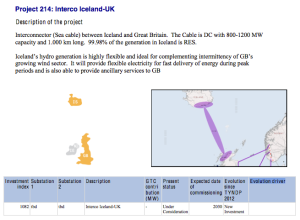Landsnet strengthening the grid
Demand for electricity in Iceland has grown immensely since the development of the current national transmission grid system, which was mostly constructed during the period 1972-1984. Since 1984 the amount of electricity being fed into the Icelandic grid has quadrupled.

The Icelandic Transmission System Operator (TSO) Landsnet is currently working on an environmental impact assessment (EIA) for a new high voltage transmission line between Southern and Northern Iceland; the South-North-Connection (SNC) over the Sprengisandur highland plateau. This new 220 kV transmission line will improve the current power transmission and increase security of supply and stability in the electric system.
Furthermore, the new line will substantially increase the transmission capacity. Thus, the project will not only be positive for better fulfilling current demand, but also prepare Landsnet to meet increased electricity demand in the coming years and decades. The increased demand will for example come from increased electrification of fish meal plants, and from new industrial production plants and services (such as data centers). Because of its stable energy supply, green energy portfolio, and yet-unharnessed renewable energy sources, Iceland is a very appealing location for companies that need substantial amount of electricity or heat for their production process. Iceland’s main power producer (Landsvirkjun) is currently offering long-term electricity contracts at a fixed price of 43 USD/MWh. Those long-term contracts are probably the most favorable in Europe and even in the whole OECD.
The basic transmission system to become 220 kV
In its Transmission Systems Plan 2014-2023 (TSP), Landsnet has proposed three different options (platforms) for the development of the Icelandic electricity grid. All three platforms aim to construct stronger connections between the major energy areas in the country, to increase stability in the transmission system and to ensure better delivery of electricity. The TSP is a.o. based on the National Master Plan for Hydro and Geothermal Energy Resources, which is a parliamentary resolution on future development of Icelandic energy resources, and an independent governmental forecast of how the electricity market will develop.

According to Landsnet, the transport capacity of the Icelandic national transmission system will be developed to be at least 220 kV. Presently, 220 kV transmission lines have only been constructed in the southwestern part of the country (between the capital region and hydropower stations in the Þjórsá and Tungnaá region) and between Fljótsdalur power plant and the aluminum smelter in Reyðarfjörðir in Eastern Iceland. The new line between Southern and Northern Iceland (SNC), over the Sprengisandur highland plateau, could become the next major 220 kV connection. This will increase operational security, flexibility and efficiency of the Icelandic transmission.
Four options of North-South-Connection over Sprengisandur will be considered

Landsnet has started the process of examining the option of South-North-Connection more closely, preparing an environmental impact assessment (EIA) of the new transmission line. According to a draft already presented in the preparation for the EIA, Landsnet will compare four options of a South-North-Connection over the Sprengisandur highland plateau.
Special emphasis is placed to minimize the visual impact of the line, as the area is largely untouched (except from gravel summer road). Parallel to this work by Landsnet, the Icelandic Road Administration will perform an EIA of a new road in the area. Of the four options on the transmission line that will be examined, one option is specified as the main advantage (with a total length of 192 km). Interestingly, one of the other options is an underground cable as part of the route.













